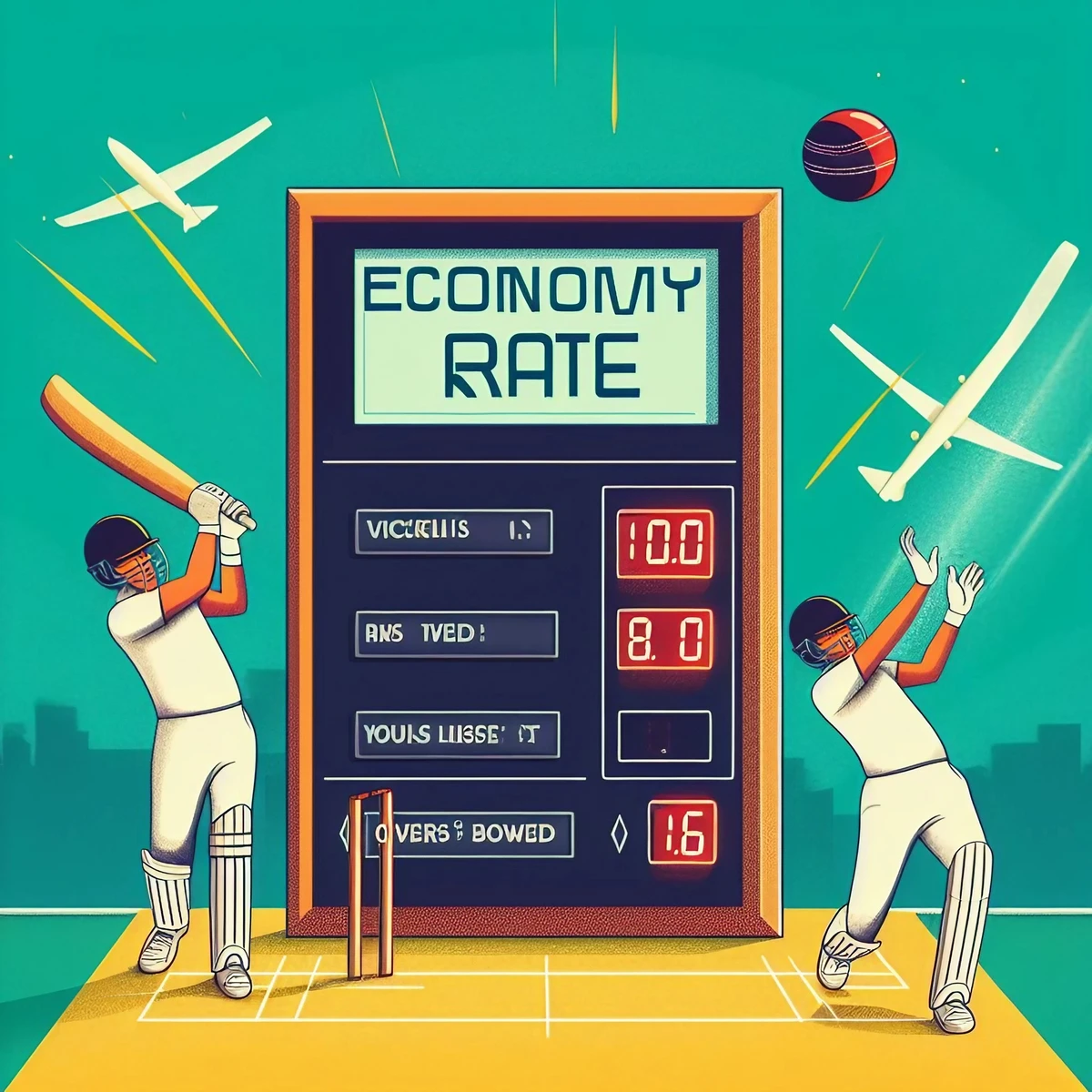Home » Cricket Calculators » Cricket Economy Rate (Econ) Calculator
Econ Calculator
Cricket Economy Rate (Econ) Calculator
Learn how to calculate the Economy Rate (Econ) in cricket, the key stat that reveals a bowler’s efficiency. Uncover the secrets behind this crucial cricket metric now!
200% Spribe Aviator Welcome Bonus
200% Spribe Aviator Welcome Bonus
- Easy Sign-Up and Deposits
- The Biggest Bonuses in India
- 450% Bonus up to ₹1,000,000
In cricket, a bowler’s economy rate (econ) measures how efficiently they concede runs per over. It indicates how “economical” or “expensive” a bowler is based on runs given up per 6 balls.
Economy rate is calculated by dividing total runs conceded by overs bowled. For example, if a bowler gives up 150 runs in 30 overs, their economy rate is 150/30 = 5.
A lower economy rate is better. Top economical bowlers maintain career rates under 4, conceding fewer than 4 runs per over.
Economy complements bowling average for assessing bowlers. In limited overs cricket, economy is especially crucial as bowlers aim to restrict scoring.
Factors like pitch, opposition, and match phase influence economy rates, but the metric evaluates bowling thriftiness over time.
Bowlers focus on optimal line, length and variation to improve economy. Coaches study economy trends to set field placements and bowling plans.
What is Economy Rate in Cricket?
The economy rate in cricket measures a bowler’s efficiency by calculating the average number of runs conceded per over.
TL;DR
Hide- The economy rate in cricket is a crucial statistic that measures a bowler’s effectiveness in terms of runs conceded per over. It provides valuable insights into a bowler’s ability to control the run flow and create pressure on the batsmen.
- A low economy rate is highly valued as it indicates a bowler’s efficiency in restricting runs. Bowlers should understand the various factors that influence their economy rate and strategize to improve it.
- Having a low economy rate is a significant factor for success in limited-overs cricket. It shows that a bowler is able to maintain a tight line and length, making it difficult for the batsmen to score freely. This puts the bowling team in a strong position and increases the chances of taking wickets.
- To achieve a low economy rate, bowlers need to focus on accuracy, consistency, and intelligent bowling tactics. By analyzing the batsmen’s strengths and weaknesses, adapting to the pitch conditions, and varying their pace and deliveries, bowlers can effectively control the run rate.
- For example, a bowler might bowl a mix of slower balls, yorkers, and well-directed bouncers to keep the batsmen guessing and prevent them from settling into a rhythm. They might also employ fielding strategies that complement their bowling style, such as setting attacking fields to induce false shots or defensive fields to restrict boundaries.
- Overall, the economy rate is an essential metric in cricket that highlights a bowler’s ability to contain the opposition’s scoring rate. It is a key factor in determining a bowler’s contribution to the team’s success and can greatly impact the outcome of a match.
To calculate the economy rate, you divide the total number of runs conceded by the total number of overs bowled and then multiply by six.
It is crucial for bowlers to maintain a low economy rate as it reflects their ability to control the flow of runs and create pressure on the batting side. This requires accuracy in line and length, variation in pace, and the skill to deceive the batsmen.
The impact of economy rate on a bowler’s career cannot be overstated. A bowler with a consistently low economy rate is highly valued in any team as they restrict the opposition’s scoring opportunities and create chances for taking wickets.
This not only contributes to the team’s success in winning matches but also enhances the bowler’s reputation and increases their chances of being selected for important tournaments.
Conversely, a high economy rate can be detrimental to a bowler’s career. It indicates a lack of control and an inability to contain the batsmen.
Bowlers with high economy rates often become targets for aggressive batsmen, leading to a loss of confidence and the possibility of being dropped from the team.
The Importance of Economy Rate for Bowlers
The economy rate holds significant value when assessing a bowler’s performance in cricket. It serves as a measure of their ability to control the flow of runs and restrict the opposing team’s scoring.
A lower economy rate often earns bowlers the trust of their team to bowl in crucial situations.
Comparing the economy rates of different bowlers provides insights into their effectiveness and contribution to the team’s success. It is a valuable tool for evaluating a bowler’s impact on the game.
Performance Evaluation Tool
Assessing bowlers’ performance effectively involves considering the economy rate as a valuable evaluation tool.
The economy rate, which measures the number of runs conceded per over, is a crucial statistic in cricket that provides insights into a bowler’s performance.
Here are four reasons why the economy rate is essential for evaluating bowlers:
- Consistency: A low economy rate indicates that a bowler consistently restricts the flow of runs, making it challenging for batsmen to score freely.
- Pressure building: Bowlers with a good economy rate can create pressure on the opposition, forcing them to take risks and make mistakes.
- Role-playing: The economy rate helps identify bowlers who excel in specific roles, such as containing runs in the middle overs or bowling at the end of the innings.
- Team strategy: The economy rate plays a crucial role in determining a team’s overall strategy as it helps captains and coaches identify the most effective bowlers in different situations.
Impact on Team Strategy
The economy rate of bowlers in cricket has a significant impact on team strategy. Captains and coaches rely on the economy rate to make tactical decisions during matches. It serves as an indicator of a bowler’s effectiveness and contribution to the team’s success.
A low economy rate suggests that the bowler is able to restrict the flow of runs, creating pressure on the batting team and increasing the chances of taking wickets.
On the other hand, a high economy rate indicates that the bowler is conceding too many runs and may need to be replaced or used strategically in specific match situations.
Comparing Bowler Effectiveness
Assessing Bowler Effectiveness: Examining Economy Rate
To accurately evaluate the effectiveness of a bowler, we can look at their economy rate, which is a crucial metric in determining their contribution to the team’s success.
By analyzing bowling economy, we can gain a comprehensive understanding of a bowler’s performance. This metric highlights their ability to control the flow of runs and create pressure on the opposition.
Let’s explore four key reasons why economy rate is essential for evaluating bowler performance:
- Consistency: A bowler with a low economy rate consistently restricts scoring opportunities for the batsmen. This makes it difficult for the opposition to build a substantial total, giving the team an advantage.
- Impact on Team Strategy: Bowlers with a good economy rate allow the team to adopt aggressive fielding positions and employ attacking tactics. They provide confidence to the team, knowing that they can rely on the bowler to keep the scoring rate in check.
- Pressure on Batsmen: When a bowler maintains a tight economy rate, it puts pressure on batsmen to take risks. This often leads to mistakes and wickets, benefiting the bowling team.
- Long-term Value: Consistently maintaining a good economy rate over a period indicates the bowler’s ability to adapt to different game situations. It shows their capability to contribute to the team’s success consistently, making them a valuable asset.
By analyzing the bowling economy, teams can identify the most effective bowlers and make informed decisions regarding their selection and role within the team.
It provides valuable insights into a bowler’s performance beyond just wickets taken, offering a comprehensive evaluation of their contribution to the team’s success.
As teams strategize and plan for matches, understanding the economy rate becomes crucial in building a strong bowling attack.
How to Calculate Economy Rate: Formula and Example
Calculating the economy rate in cricket is a simple process. You divide the number of runs conceded by the number of overs bowled. The economy rate is an important metric for evaluating a bowler’s performance and efficiency on the field.
It provides valuable insight into how many runs a bowler gives away on average per over. A lower economy rate indicates better performance as it suggests that the bowler is able to restrict the opposing team’s scoring opportunities.
To improve their economy rate, bowlers can employ various techniques. One effective technique is to focus on delivering the ball consistently in the right areas, known as line and length.
- Net Run Rate Calculator: How to Calculate Run Rate in Cricket
- Cricket Batting Average Calculator
- Cricket Batting Strike Rate Calculator
- Cricket Bowling Average Calculator
- Cricket Bowling Strike Rate Calculator
- Cricket Economy Rate (Econ) Calculator
- Cricket Follow On Calculator
- Cricket Runs per Over Calculator
By doing this, bowlers make it difficult for the batsman to score runs, reducing their chances of giving away too many runs.
Varying the pace of the delivery and using deceptive deliveries like slower balls or cutters is another strategy to consider. These variations can confuse the batsman and make it harder for them to time their shots effectively, resulting in mistimed shots and fewer runs.
In the next section, we’ll delve into the factors that can affect a bowler’s economy rate in more detail. These factors include pitch conditions, fielding quality, and the type of bowler.
By understanding these factors, bowlers can further refine their strategies and contribute to their team’s success by improving their economy rate.
Remember, calculating the economy rate is just the first step. By implementing effective techniques and considering the influencing factors, bowlers can enhance their performance and make a significant impact on the game.
Quote: ‘Improving the economy rate is not just about numbers. It’s about making a difference on the field and contributing to the team’s success.’
Factors Affecting a Bowler’s Economy Rate
There are several factors that can significantly affect a bowler’s economy rate in cricket. One important factor is the bowler’s style of bowling.
Different styles have varying levels of effectiveness in restricting the flow of runs. For example, a bowler who specializes in spin bowling may have a better chance of keeping the scoring rate low compared to a fast bowler.
Another factor that plays a crucial role is the pitch conditions. The nature of the pitch can greatly influence how difficult it is for batsmen to score freely.
Slower pitches tend to favor the bowlers as it becomes harder for the batsmen to hit boundaries and score quickly. On the other hand, flat and fast pitches can make it challenging for bowlers to contain the batsmen.
Additionally, the opposition’s batting order can also impact a bowler’s economy rate. If a bowler has to face stronger batsmen early on, it can result in a higher economy rate.
This is because better batsmen are more likely to score runs and find gaps in the field, putting pressure on the bowler.
Bowling Style Impact
Factors that can impact a bowler’s economy rate in cricket include their bowling style. The way a bowler delivers the ball and their overall technique can play a significant role in maintaining a low economy rate.
Let’s take a look at some key factors that can influence a bowler’s economy rate:
- Bowling speed: The pace at which a bowler delivers the ball can have an impact on their economy rate. Fast bowlers who consistently bowl at high speeds can put pressure on the batsmen, making it difficult for them to score freely.
- Fielding strategy: The fielding positions set by the captain and the overall fielding strategy can also affect a bowler’s economy rate. Well-placed fielders can restrict the batsmen from finding gaps and scoring runs easily.
- Accuracy: Bowlers who can consistently bowl in the right areas, hitting the right length and line, can make it challenging for the batsmen to score runs. This can lead to a lower economy rate.
- Deception and variations: Bowlers who possess the skill to deceive the batsmen with variations in pace, grip, and trajectory can often keep the runs in check. By outsmarting the batsmen, they can prevent them from scoring freely and maintain a low economy rate.
Pitch Conditions Influence
The condition of the pitch has a significant impact on a bowler’s economy rate in cricket. The state of the pitch and the weather can greatly affect the movement and bounce of the ball, making it easier or more difficult for the batsmen to score runs.
A dry and dusty pitch tends to break up and offer more assistance to spinners, making it harder for batsmen to score freely.
On the other hand, a green and grassy pitch provides more assistance to fast bowlers, causing the ball to seam and swing, making it challenging for the batsmen to score runs.
Additionally, weather conditions such as wind speed and humidity can also influence the movement of the ball.
Therefore, bowlers need to adapt their strategies and bowling techniques according to the pitch and weather conditions to maintain a good economy rate.
Opposition Batting Order
Analyzing the batting order of the opposition is crucial in determining a bowler’s economy rate in cricket.
The strength and composition of the opposition’s batting lineup directly impact the pressure and challenges faced by the bowler.
Here are four key factors to consider in batting order analysis:
- Opening Pair: The performance of the opening batsmen sets the tone for the innings. A strong opening pair can accumulate runs quickly, increasing the pressure on the bowler.
- Middle Order: The middle order is responsible for stabilizing the innings and building partnerships. A strong middle order can be difficult to break through, resulting in a higher economy rate for the bowler.
- Lower Order: The tailenders in the batting order often struggle to score runs consistently. Bowling against the lower order can provide an opportunity for the bowler to take wickets and improve their economy rate.
- Batting Depth: The depth of the opposition’s batting lineup indicates how long the bowler will be required to bowl. A deep batting lineup can mean more overs to bowl, potentially increasing the chances of a higher economy rate.
Understanding the Significance of a Low Economy Rate
A low economy rate in cricket is a highly valued statistic that indicates a bowler’s ability to restrict the flow of runs during their allotted overs. In the fast-paced and high-scoring format of T20 cricket, a bowler with a low economy rate becomes an invaluable asset to their team.
4. Benefits of a Low Economy Rate
1. Puts pressure on the opposition batsmen
By maintaining a low economy rate, a bowler puts pressure on the opposition batsmen, forcing them to take risks and play shots they may not be comfortable with. This often leads to mistakes and wickets for the bowling team.
2. Restricts the scoring rate
A low economy rate restricts the scoring rate of the opposition, making it harder for them to accumulate runs quickly. This puts the batting team under pressure, forcing them to take risks and make mistakes.
3. Builds pressure on the batting team
Furthermore, a low economy rate increases the chances of taking wickets. When a bowler consistently bowls economically, the batsmen are more likely to make mistakes in an attempt to score runs, resulting in wickets for the bowling team.
4. Increases the chances of taking wickets
Overall, a low economy rate is a crucial factor in a bowler’s success and can greatly impact the outcome of a cricket match. It puts pressure on the opposition, restricts the scoring rate, and increases the chances of taking wickets. A bowler with a low economy rate is an asset to their team and plays a significant role in their success.
A bowler with a low economy rate can control the game and put the opposition under immense pressure
Analyzing the Impact of a High Economy Rate
The economy rate in cricket can greatly affect a team’s performance. When the economy rate is high, it puts pressure on the fielding side because it allows the opposition to score runs more easily.
Teams that have bowlers consistently with high economy rates need to strategize on how to minimize the impact and improve the performance of their bowlers.
Comparing the economy rates of different bowlers can provide valuable insights into their effectiveness, helping teams make informed decisions when it comes to team selection and game strategy.
It is crucial for teams to analyze and address the impact of a high economy rate to improve their chances of success on the cricket field.
Impact on Team Performance
How does a high economy rate affect a cricket team’s performance? A high economy rate can negatively impact a team in several ways. Here are four key ways in which it can affect the team:
- Increased pressure on other bowlers: When one bowler is conceding runs at a high economy rate, it puts additional pressure on the rest of the bowling lineup. They have to work harder to make up for the runs given away by the high economy rate bowler.
- Difficulty in building pressure: A high economy rate makes it challenging for the team to build pressure on the opposing batsmen. This allows the opposition to score freely and puts the fielding team on the back foot.
- Reduced confidence: Bowlers with a high economy rate may start to lose confidence in their abilities. This can affect their overall performance and decision-making on the field.
- Comparison of bowler effectiveness: A high economy rate allows for a clearer comparison of the effectiveness of different bowlers within the team. It highlights the need for strategic changes and potentially replacing the high economy rate bowler with someone who is more economical.
It is crucial for teams to manage their bowlers’ economy rates effectively in order to maintain control and put pressure on the opposition.
Strategies for Improvement
To address the impact of a high economy rate on a cricket team’s performance, there are strategic measures that can be implemented to enhance a bowler’s efficiency and control.
One key aspect is bowler consistency, which refers to the ability to deliver accurate and repeatable deliveries.
By maintaining a consistent line and length, bowlers can make it difficult for batsmen to score freely, reducing the number of scoring opportunities for the opposition.
In addition to consistency, variations in bowling play a crucial role in keeping the economy rate low. Bowlers can deceive batsmen and restrict their scoring options through changes in pace, spin, or swing. These variations make it challenging for batsmen to predict and effectively score runs.
To improve their economy rate and contribute to the team’s success, bowlers need to continuously work on their skills, regularly analyze their performance, and adapt their strategies. By doing so, they can identify areas for improvement and make the necessary adjustments.
Strategies for Improvement:
- Focus on bowler consistency: Maintain a consistent line and length to make it difficult for batsmen to score freely.
- Utilize variations in bowling: Incorporate changes in pace, spin, or swing to deceive batsmen and restrict their scoring options.
- Analyze performance regularly: Continuously assess performance to identify areas for improvement and make necessary adjustments.
Comparing Different Bowlers
Analyzing the impact of a high economy rate can be done by comparing different bowlers.
When evaluating bowlers, it is important to consider several factors to understand the implications of a high economy rate.
Here are four key points to consider:
- Consistency: By comparing bowlers based on their economy rate, we can identify those who consistently maintain a low rate. This showcases their ability to control runs and apply pressure on batsmen.
- Match situation: Analyzing the economy rate in various match situations allows teams to assess how bowlers perform under pressure. This information can help make informed decisions about player selection.
- Role in the team: Comparing the economy rates of bowlers fulfilling different roles, such as strike bowlers or containment bowlers, provides insights into their effectiveness in their respective positions.
- Impact on player contracts: A high economy rate can affect a bowler’s value in player contracts. Teams prioritize bowlers who can control the run flow and restrict the opposition’s scoring, making it an important consideration in contract negotiations.
Economy Rate Vs. Bowling Average: Key Differences
In cricket, economy rate and bowling average have distinct differences. While both metrics are used to evaluate a bowler’s performance, they provide different insights into their effectiveness on the field.
Bowling average is a commonly used statistic that measures the average number of runs conceded by a bowler per wicket taken. It is calculated by dividing the total runs conceded by the total number of wickets taken.
However, the bowling average has certain limitations. It does not take into account the number of overs bowled or the economy rate, which can provide a more accurate representation of a bowler’s performance.
On the other hand, economy rate is a measure of a bowler’s ability to restrict the flow of runs. It is calculated by dividing the total runs conceded by the total number of overs bowled and is expressed as the average number of runs conceded per over.
Unlike the bowling average, the economy rate takes into account the number of overs bowled, providing a more accurate measurement of a bowler’s efficiency in terms of run containment.
While the bowling average provides insights into a bowler’s ability to take wickets, the economy rate gives a better indication of their overall performance in terms of run control.
Therefore, it is important to consider both metrics together to gain a comprehensive understanding of a bowler’s effectiveness on the cricket field.
Role of Economy Rate in Limited-Overs Cricket
The economy rate plays a crucial role in limited-overs cricket as it helps assess a bowler’s effectiveness in controlling the flow of runs on the field.
It measures the number of runs a bowler concedes per over and is used by teams to determine which bowlers can apply pressure on the opposition and restrict the scoring rate.
There are several reasons why the economy rate is significant in limited-overs cricket:
- Assessing bowler pressure: A low economy rate indicates that a bowler can maintain control and put pressure on the batsmen, making it challenging for them to score freely. This can lead to wickets and a decrease in the run rate.
- Determining economic bowler selection: Teams prioritize bowlers with a good economy rate as they can help build pressure and create opportunities for breakthroughs. This is especially crucial in limited-overs cricket, where restricting the opposition’s scoring is essential.
- Setting a target: In limited-overs cricket, teams set a target based on the expected run rate. Bowlers with a good economy rate play a vital role in keeping the opposition’s score within manageable limits, making it easier for their team to chase the target.
- Controlling the middle overs: The middle overs of a limited-overs match are crucial, and bowlers with a good economy rate can keep the opposition in check during this phase, preventing them from building a strong platform for a big total.
Strategies to Improve Economy Rate for Bowlers
Bowlers can improve their economy rate by implementing effective strategies to minimize runs conceded. One important aspect is mastering various bowling techniques.
Bowlers should focus on bowling accurately, hitting the right line and length consistently, which can make it difficult for batsmen to score freely.
Mixing up deliveries with slower balls, yorkers, and bouncers can keep the batsmen guessing and restrict their scoring opportunities.
Another useful strategy is to vary the pace of deliveries, as sudden changes in speed can disrupt the batsman’s timing and force them into making mistakes.
Mental preparation also plays a crucial role in improving the economy rate. Bowlers should develop a strong mindset and remain calm under pressure.
They should avoid getting frustrated or panicking when a few boundaries are hit. Instead, they should focus on executing their plans and maintaining a disciplined approach. Remaining patient and sticking to the basics can help bowlers minimize runs conceded.
Furthermore, studying the opposition batsmen and their weaknesses can provide bowlers with valuable insights.
By identifying the batsman’s preferred shots and areas of vulnerability, bowlers can formulate plans to exploit those weaknesses and reduce the scoring opportunities.
Famous Bowlers With Impressive Economy Rates
Several well-known cricketers have showcased their exceptional ability to control runs conceded during matches, reflected in their impressive economy rates.
These bowlers have become highly valued assets to their teams due to their skill in restricting the opposition’s scoring rate.
Let’s take a look at four notable bowlers with high economy rates:
- Muttiah Muralitharan: Widely regarded as one of the greatest bowlers in cricket history, the legendary Sri Lankan spinner had an impressive economy rate of 3.89 in ODIs. Muralitharan consistently frustrated batsmen with his deceptive spin and accuracy, making it difficult for them to score freely.
- Glenn McGrath: Known for his precision and discipline, Australian pace bowler McGrath had an impressive economy rate of 3.88 in ODIs. Batsmen often found it challenging to score against him due to his ability to consistently hit the right line and length.
- Anil Kumble: The former Indian leg-spinner was a master of control, evident from his economy rate of 4.30 in ODIs. Kumble’s accuracy, combined with his variations in spin and flight, made him a formidable opponent for any batting lineup.
- Shaun Pollock: The South African medium-fast bowler possessed remarkable control over his line and length, resulting in an economy rate of 3.67 in ODIs. Pollock’s ability to keep the runs in check while also taking wickets made him a crucial asset for his team.
The impressive economy rates of these bowlers not only highlight their skill and discipline but also emphasize the importance of economy rate in determining player contracts.
Teams recognize the value of bowlers who can effectively restrict runs, making them highly sought after in the cricketing world.
As former Australian cricketer Brett Lee once said, ‘A good economy rate is like gold dust in modern-day cricket.’
Conclusion
The economy rate in cricket is an important statistic that measures a bowler’s effectiveness in terms of runs conceded per over. It provides insights into a bowler’s ability to control the run flow and put pressure on the batsmen.
A low economy rate is highly valued as it indicates a bowler’s efficiency in restricting runs. Bowlers should understand the factors that influence their economy rate and employ strategies to improve it.
A low economy rate is a significant factor for success in limited-overs cricket.
Frequently Asked Questions
What does economy rate mean?
In cricket, a bowler’s economy rate measures the average number of runs they concede per over bowled. It indicates how efficiently a bowler concedes runs.
How do you calculate the economy rate in cricket?
Economy rate is calculated by dividing the total runs given up by the bowler by the number of overs bowled. For example, 150 runs conceded in 30 overs gives an economy rate of 150/30 = 5.
What is the best economy rate in ODI history?
The best ODI economy rate record belongs to Australian bowler Geoff Dymock, who conceded just 3.05 runs per over in his career.
Get up to ₹20,000 Bonus Every Week!
Get up to ₹20,000 Bonus Every Week!
- UPI, Paytm, gPay & PhonePe withdrawals
- The Biggest Bonuses in India
- 450% Bonus up to ₹1,000,000
What is the lowest economy in cricket history?
In Test cricket, the record for the lowest economy rate belongs to South Africa’s Bruce Murray, who incredibly conceded just 1.84 runs per over in his 10 match career.
Other Cricket Calculators
Latest Cricket Posts
Claim 200% Welcome Bonus
For a limited time, every new member can claim 200% Welcome Bonus upon registration up to ₹15,000. Read to bet?














